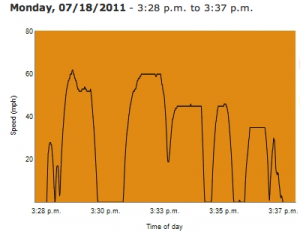Progressive offers a discount program called Snapshot where they electronically monitor your driving “to get away from the law of large numbers and focus on how you personally drive” (says my agent).
Here’s the deal. First, Progressive monitors three aspects of your driving:
- When do you drive? Midnight to 4 am are “high risk” hours. On weekdays, “medium risk” times are 4 am to 9 am, 3 pm to 6 pm, and 9 pm to midnight. On weekends it’s just 4 am to 6 am and 9 pm to midnight. All other times are “low risk”.
- How far do you drive? Averaging less than 30 miles per day (over a one week period) is good.
- How hard do you brake? Decelerating at 7 mph per second or faster is bad.
That last one is the hardest to intuit, since we don’t have deceleration gauges in our cars. Twice this week I’ve braked suddenly to avoid hazards (e.g., the guy who merged into my lane while I was still in it), and neither registered as a “hard brake”. Two others that didn’t feel sudden to me at the time did register.
Progressive is aware, of course, that sometimes stopping short is the safest maneuver. As my agent put it, “As your insurance company, we’d rather you brake hard than make us buy you a new car.” But doing it too often suggests you’re following too close: you should have time to decelerate gracefully even when the car in front of you stops.
The website shows a detailed graph of your speed during each “trip” (each time the ignition was started and then stopped). Knowing the route, it’s easy to figure out what happened when. Here, I left our neighborhood for the 60 mph highway, stopped at a red light in the middle, decelerated to turn onto a 45 mph road, et cetera. I can even see where I stopped at a light, inched into the intersection when it turned green, and then made my left turn.
But presumably you wouldn’t have deduced my route from my speed alone, and neither can Progressive. The tracking device does not have GPS installed.
(This doesn’t make it any less creepy that I can tell every time my wife stops for a Starbucks from the telltale “mostly stopped with occasional momentary 3 mph spikes” graph and the extra mileage.)
Progressive offers an initial discount after collecting data for 30 days, then a final discount after six to twelve months. “Final” means Progressive offers an initial discount after collecting data for 30 days, and then a final discount after six to twelve months. That final discount is permanent — you keep it as long as you’re insured with Progressive. When they first offered the program bad drivers could suffer a 5% increase, but they phased that out. Now the worst penalty is “no discount” and the best is 30% off.
A couple more facts that may be useful:
- New trips appear on the website within a few hours.
- The speed graph is a fixed size, so longer trips just get crammed into the same space, and a lot of the detail is lost. For trips of about five miles, it’s about the right size.
- The speed graph doesn’t specifically indicate where your “hard brakes” are. You can sometimes tell visually, but it’s guesswork.
